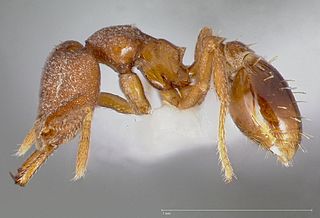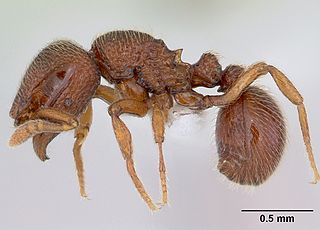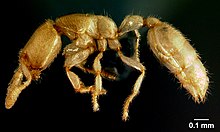
Ponerinae, the ponerine ants, is a subfamily of ants in the Poneromorph subfamilies group, with about 1,600 species in 47 extant genera, including Dinoponera gigantea - one of the world's largest species of ant. Mated workers have replaced the queen as the functional egg-layers in several species of ponerine ants. In such queenless species, the reproductive status of workers can only be determined through ovarian dissections.

Odontomachus is a genus of ants commonly called trap-jaw ants found in the tropics and subtropics throughout the world.

Aphaenogaster is a genus of myrmicine ants. About 200 species have been described, including 18 fossil species. They occur worldwide except in South America south of Colombia, sub-Saharan Africa, and Antarctica.

Monomorium is a genus of ants in the subfamily Myrmicinae. As of 2013 it contains about 396 species. It is distributed around the world, with many species native to the Old World tropics. It is considered to be "one of the more important groups of ants," considering its widespread distribution, its diversity, and its variety of morphological and biological characteristics. It also includes several familiar pest species, such as the pharaoh ant and the flower ant.

Strumigenys is a genus of ants in the subfamily Myrmicinae.

Tetramorium is a genus of ants in the subfamily Myrmicinae that includes more than 520 species. These ants are also known as pavement ants.

Solenopsidini is a tribe of myrmicine ants with about 20 genera.

Acropyga is a genus of small formicine ants. Some species can be indirect pests. A. acutiventris, which is found from India to Australia, tends subterranean, root-feeding mealybugs of the species Xenococcus annandalei. Living, gravid females are carried in the jaws of A. acutiventris queens during their nuptial flight, to establish the symbiotic association in founding colonies. Other Acropyga species have relationships with different species of mealybugs, and it could be a trait common to the whole genus.

Aenictus is a large army ant genus distributed in the Old World tropics and subtropics. It contains about 181 species, making it one of the larger ant genera of the world.

Plectroctena is an Afrotropical genus of ants, with most species occurring in the rainforest zones of West and Central Africa. Some species are cryptic or subterranean foragers, while others forage in open grassland terrain. The workers forage singly or in groups of 2 to 3. They nest in the earth at varying depths, or in collapsed logs. They prey mainly on millipedes, including their young or eggs.

Dolichoderus is a genus of ants found worldwide.

Linepithema is a genus of small ants in the subfamily Dolichoderinae.

Technomyrmex is a genus of ants in the subfamily Dolichoderinae. With 98 species, it is one of the largest and most diverse ant genera in the Dolichoderinae. The genus distributed throughout the tropical and subtropical zones with most species occurring in the Oriental-Malesian and Afrotropical regions. One species, Technomyrmex albipes is a tramp ant now widespread throughout the tropics due to human activities.

Terataner is an African genus of arboreal ants in the subfamily Myrmicinae.

Dicroaspis is an African genus of ants in the subfamily Myrmicinae.

Ocymyrmex is an African genus of ants in the subfamily Myrmicinae, also commonly known as hotrod ants.

Ooceraea is a genus of ants in the subfamily Dorylinae containing approximately 16 described species. The genus is distributed across the Australasia, Indomalaya, Malagasy, Neotropical, Oceania, and Palearctic bioregions. Ooceraea was described by Roger (1862) and later placed as a junior synonym of Cerapachys by Brown (1973). Ooceraea was resurrected as a valid genus by Borowiec (2016) during redescription of the doryline genera.

Brachyponera is a genus of ants in the subfamily Ponerinae.

Anillomyrma decamera is an Asian species of ant in the subfamily Myrmicinae found from Philippines, India, Sri Lanka, Taiwan, Vietnam, and China.



















